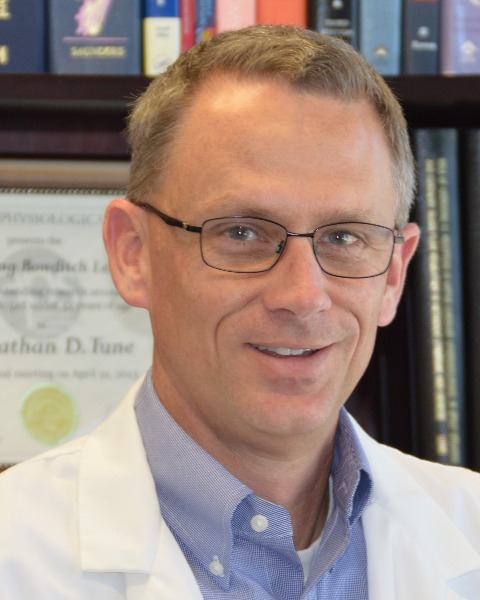Cardiovascular Engineering
Advancements in Experimental & Computational Cardiovascular Engineering
Insights into large animal models as translational tools for advancing cardiovascular disease
Thursday, October 12, 2023
3:00 PM - 3:30 PM PDT
Location: 338 (Center, Level 3)

Johnathan Tune, PhD
Professor and Chair
University of North Texas
Fort Worth, Texas, United States
Presenting Author(s)
Introduction:: Large animal models are a vital tool for understanding basic and pathophysiologic mechanisms responsible for the initiation and progression of cardiovascular disease. Such models remain a vital tool for the development and advancement of novel diagnostic and therapeutic approaches to mitigate cardiovascular morbidity and mortality. The purpose of this session is to highlight key factors to consider when performing large animal (swine) studies of cardiovascular and hemodynamic performance. These considerations include, anatomic, metabolic, sex, and age as well as attention to specific experimental approaches required to yield essential end points unique to each study. Advantages and disadvantages of distinct approaches and how key variables can be leveraged for computational multi-scale and finite element modeling will also be addressed.
Materials and Methods:: Dr. Johnathan Tune is a leading expert on swine models and he will share his experience and methodologies related to models of coronary blood flow and cardiac mechanics. Considerations include, anatomic, metabolic, sex, and age as well as attention to specific experimental approaches required to yield essential end points unique to each study will be discussed. The use of strategically located flow probes, pressure probes and novel tools that can be used to enhance the study of cardiovascular hemodynamics will be discussed.
Results, Conclusions, and Discussions:: In this special session, results from large animal studies that capture cardiovascular hemodynamics, cardiac pressure-volume relationships and other key physiologic biomarkers and parameters will be shared. The importance of anesthesia selections, veterinary support and surgical support will be highlighted. Additionally, advantages and disadvantages of distinct approaches and how key variables can be leveraged for computational multi-scale and finite element modeling will also be addressed. To advance the field of cardiovascular medicine there will be a need for multidisciplinary team based science.
Acknowledgements (Optional): :
References (Optional): :
Materials and Methods:: Dr. Johnathan Tune is a leading expert on swine models and he will share his experience and methodologies related to models of coronary blood flow and cardiac mechanics. Considerations include, anatomic, metabolic, sex, and age as well as attention to specific experimental approaches required to yield essential end points unique to each study will be discussed. The use of strategically located flow probes, pressure probes and novel tools that can be used to enhance the study of cardiovascular hemodynamics will be discussed.
Results, Conclusions, and Discussions:: In this special session, results from large animal studies that capture cardiovascular hemodynamics, cardiac pressure-volume relationships and other key physiologic biomarkers and parameters will be shared. The importance of anesthesia selections, veterinary support and surgical support will be highlighted. Additionally, advantages and disadvantages of distinct approaches and how key variables can be leveraged for computational multi-scale and finite element modeling will also be addressed. To advance the field of cardiovascular medicine there will be a need for multidisciplinary team based science.
Acknowledgements (Optional): :
References (Optional): :
